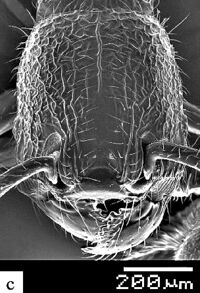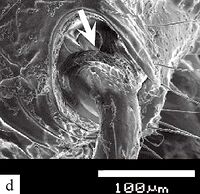Myrmecina nomurai
| Myrmecina nomurai | |
|---|---|

| |
| Scientific classification | |
| Kingdom: | Animalia |
| Phylum: | Arthropoda |
| Class: | Insecta |
| Order: | Hymenoptera |
| Family: | Formicidae |
| Subfamily: | Myrmicinae |
| Tribe: | Crematogastrini |
| Genus: | Myrmecina |
| Species complex: | vieti |
| Species: | M. nomurai |
| Binomial name | |
| Myrmecina nomurai Okido, Ogata & Hosoishsi, 2020 | |
Nothing is known about the biology of Myrmecina nomurai.
Identification
Okido, Ogata, and Hosoishi (2020) - A member of the Myrmecina vieti complex. Among these species, M. nomurai can be distinguished by a short and sculptured petiole that is expanded laterally at the anterior portion in dorsal view, and mesosoma with longitudinal and parallel rugae.
Keys including this Species
Distribution
Distribution based on Regional Taxon Lists
Oriental Region: Vietnam (type locality).
Distribution based on AntMaps
Distribution based on AntWeb specimens
Check data from AntWeb
Countries Occupied
| Number of countries occupied by this species based on AntWiki Regional Taxon Lists. In general, fewer countries occupied indicates a narrower range, while more countries indicates a more widespread species. |

|
Biology
Castes
Worker
Nomenclature
The following information is derived from Barry Bolton's Online Catalogue of the Ants of the World.
- nomurai. Myrmecina nomurai Okido, Ogata & Hosoishsi, 2020: 78, fig. 36 (w.) VIETNAM.
Unless otherwise noted the text for the remainder of this section is reported from the publication that includes the original description.
Description
Worker
Holotype. TL 2.24, HL 0.56, HW 0.53, CI 94, SL 0.43, SI 82, PW 0.35, ML 0.60. Paratype worker. TL 2.34, HL 0.58, HW 0.53, CI 90, SL 0.46, SI 88, PW 0.35, ML 0.63 (1 measured).
Head subrectangular, longer than broad in full-face view; median portion of occipital margin moderately concave; occipital corners rounded, not projected posteriorly. Masticatory margin of mandible bent at midlength (third small tooth or sixth tooth); apical tooth strong, third tooth acute, followed by 5 small teeth and a stout basal tooth bearing blunt apex. Dorsal surface of clypeus slightly concave; median portion of anterior margin weakly projected with small median process but frequently unclear; lateral portion raised into a sharp ridge of shield wall on each side, in front of antennal insertions. Anterior dorsal surface of labrum with paired denticles fused with each other at base. Frontal carinae present and running back to or beyond the level of the posterior margin of the eyes, but frequently unclear. Eyes very small, varying in size with maximum diameter 0.06 mm and 6-7 ommatidia. Antennal scape short, just reaching posterolateral corner of head; antennal flange fully developed.
Dorsal outline of mesosoma more or less flattened in profile. Pronotum without denticles; anterior ventrolateral portion not angulate. Eumetanotal spine present but small. Propodeal spine triangular, directing slightly upward and backward, not reaching vertical posteriormost limit of propodeum in profile. Propodeal lobe low. Propodeal spiracle large, situated near base of propodeal spine, apart from margin by its diameter. Petiole short; small dorsal crest located almost at midlength in profile; subpetiolar process projecting forward with acute apex. Postpetiole much broader than petiole and usually expanded anteriorly in dorsal view; lateral portion strongly marginated; dorsal outline flattened in profile; ventral outline projected forward with acute apex at anterior portion.
Anterior margin of gaster concave in dorsal view.
Head weakly punctured with irregular rugae which are thin, but variable; ventrolateral portion weakly punctured or smooth and shining, without rugae. Mandibles sometimes with yellow spot on dorsal surface. Clypeus smooth and shining. Mesosoma with irregular rugae which are thin in profile. Petiole and postpetiole with a few longitudinal rugae. First gastral tergum weakly punctured on dorsal surface. Head with sparse pilosity on dorsum. Mesosoma with sparse pilosity on dorsum, hairs of pronotum longer than propodeal spines and shorter than that of petiole and postpetiole. Petiole and postpetiole with or without hairs on ventral surface. Head, mesosoma, petiole and postpetiole varying from yellowish brown to reddish brown, gaster dark reddish brown.
Type Material
Holotype worker, VIETNAM: Tam Dao, 900 m alt., Vinh Phuc Prov., 9. xi. 1999, VN99-HO-054 (H. Okido) (Entomological Collection of the Institute of Ecology and Biological Resources). Paratypes. 3 workers with same data as holotype (Kagoshima University, Faculty of Science, Entomological Laboratory and Institute of Tropical Agriculture, Faculty of Agriculture, Kyushu University).
References
- Brassard, F., Leong, C.-M., Chan, H.-H., Guénard, B. 2021. High diversity in urban areas: How comprehensive sampling reveals high ant species richness within one of the most urbanized regions of the world. Diversity 13, 358 (doi:10.3390/d13080358).
- Okido, H., Ogata, K., Hosoishsi, S. 2020. Taxonomic revision of the ant genus Myrmecina in Southeast Asia (Hymenoptera: Formicidae). Bulletin of the Kyushu University Museum. 7:1-108.

